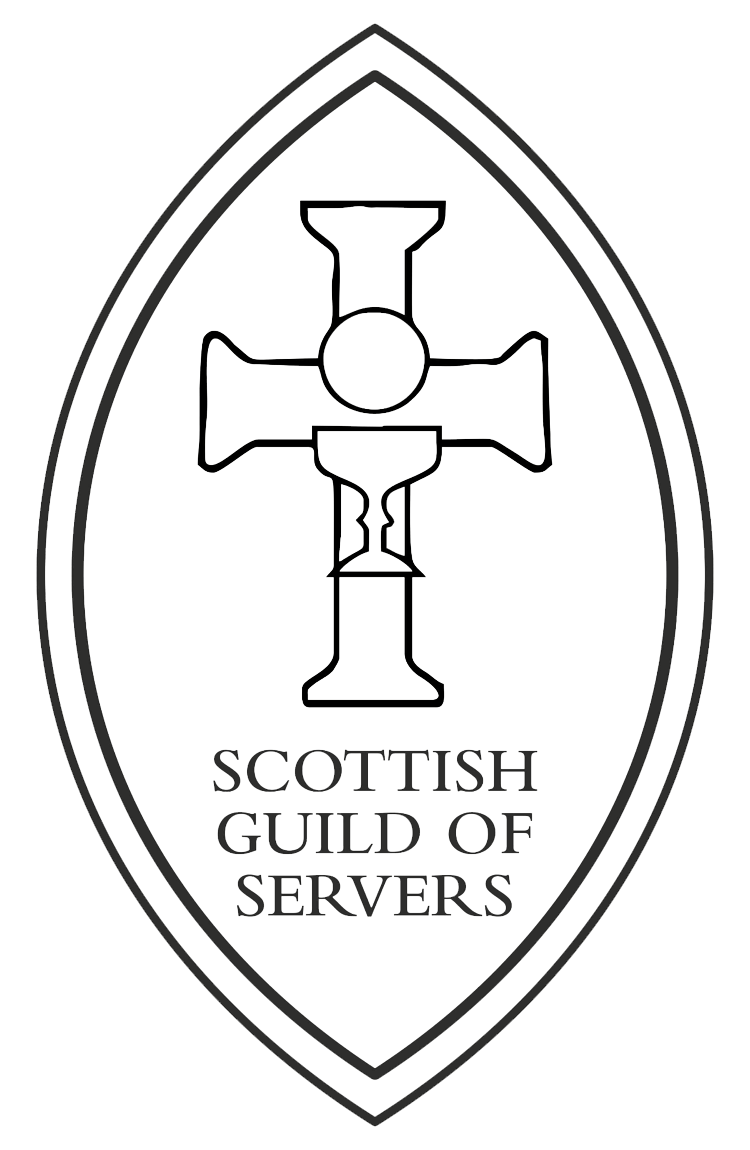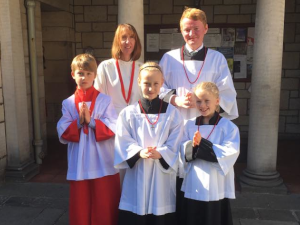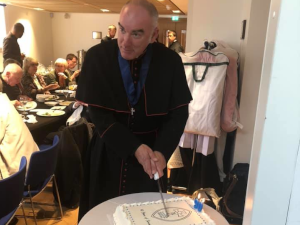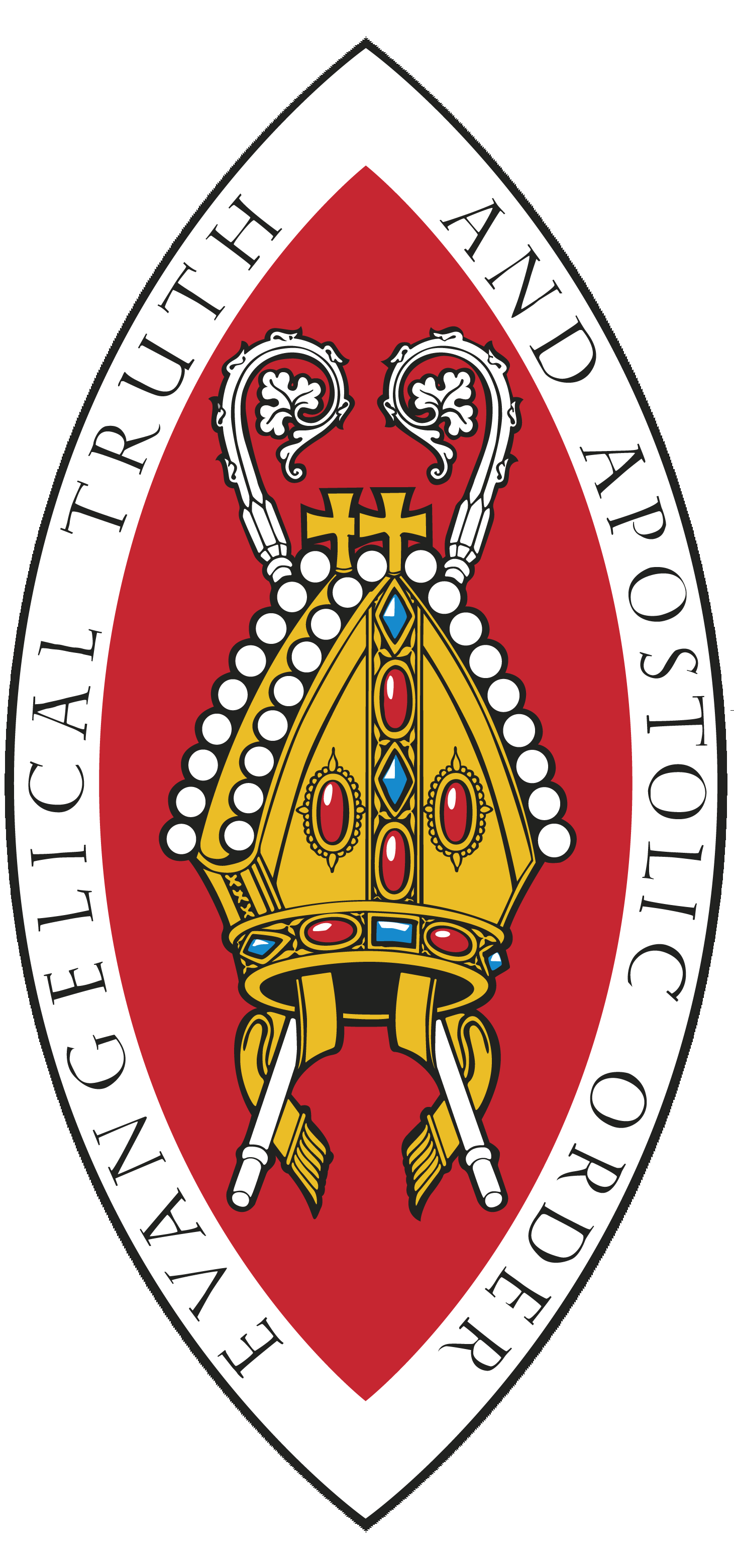What is Altar Serving?
As altar servers, we play an important role in the celebration of the Church’s liturgy. Good servers should be quiet and unobtrusive. We are there to assist the Priest at the altar and, with dignity and discretion, facilitate others’ participation in the liturgy.
The good server is efficient and helpful and carries out allotted tasks so that the flow of the liturgy is not interrupted. For example, when assisting the Priest at the offertory the server should present the cruets in a way that is most helpful i.e. with the handles facing outwards. At the same time, the server should perform all tasks without being overly-elaborate, yet with a sense of ceremony that will contribute to the atmosphere of prayer and worship.
Ceremonial is important. We bring the use of our senses into the liturgy. What the congregation observes the server doing can make a difference to how the liturgy is experienced. The Master of Ceremonies (MC) especially should be aware of the effect the servers’ actions will have on others.
Good serving is based on knowledge of the Church’s liturgy, so understanding why things happen will make the difference between serving that is intelligent and wholehearted and that which is merely mechanical.
Serving is praying, as it is part of the Church’s worship of God. Praying is something we do with our bodies as well as our hearts and it is something we do for other people as well as for ourselves. As servers, we pray when we contribute to the prayer of others. Ideally, servers should gather together for prayer before the liturgy. It is better still if the Celebrant and other priests are part of this.
Good serving should be relaxed but attentive. Tension and worry often lead to mistakes and servers looking regimented. Accept that mistakes will happen, even in the most carefully rehearsed ceremonies.
Serving is a privilege, not because it is more important than any other ministry, but because it is a sign of a gift of the Holy Spirit for the benefit of the Church. Serving is service.
What do Servers do?
Serving is all about teamwork. In smaller churches or on weekdays the team may only comprise one priest and one server while larger teams are made up of multiple servers working alongside the Priest, Deacon, Sub-Deacon and perhaps even the Bishop. Serving needs to be quiet and unobtrusive: the saying that “there is no “I” in “team”certainly applies to serving at the altar. The tasks that altar servers carry out are designed to assist the clergy and allow the act of worship to flow without any interruption. The start of our Guild prayer is: “O God who has called us to assist at thy Holy Altar”…
Although each individual church may have different numbers of people who serve at a particular service, the jobs which need doing are largely similar. Acolytescarry candles beside the cruciferwho carries the processional cross.
It is interesting that the church has always used the Latin word “crucifer”as a name for the person who carries the processional cross but the Greek word “acolyte”for people who carry processional candles. The word “crucifer”is derived from the Latin “crucis”(cross) and “fere”(to bear). The equivalent Latin word for someone who bears a light would be “Lucifer”! Instead, the word “acolyte”which comes from the Greek “akolouthos” meaning server or follower is used.
CRUCIFER
It is appropriate that a cross, the most instantly recognisable of Christian symbols is carried in church processions. Some processional crosses are larger, more ornate (and heavier!)than others. Some are crucifixes with our Lord’s suffering for our sake clearly on display; others are empty and remind us of the cross left behind after the resurrection. In some early churches the processional cross detached from the pole on which it was carried and was also used as an altar cross. Many congregation members bow as the processional cross passes them as a reverence to the flag and banner which all Christians follow therefore the job of the crucifer is an important one which needs to be performed with dignity.
The cross needs to be held by both hands which are far enough apart so that the cross is held stable and does not sway from side to side as the crucifer is walking. The cross should be held high enough so that the crucifer can walk freely without the lower part of the pole hitting his or her legs. If an image of our Lord on the cross is present then the crucifer should make sure that this faces forwards. It goes without saying that the crucifer is unable to genuflect or bow, to do so risks an accident with the top heavy cross crashing down to the ground. The crucifer reverences the altar by pausing, standing straight in-front of the altar for a second before moving away.
The cross is carried: during the introit procession when the altar party enter the sanctuary; during any seasonal procession around the church, for example the penitential procession during Lent (anti-clockwise around the church) or the triumphant procession on Easter day (clockwise around the church); for the Gospel procession and during the recessional procession when the altar party leaves the sanctuary.
ACOLYTE
The acolytes work in pairs, carrying candles at various points during worship but they also help in other practical ways. Some churches have a second set of processional candles or lights which have glass casing for use outdoors, the servers who carry these are referred to as torch bearers.
When in procession, candles should be held level so that hot wax is not spilled. It looks best when both acolytes candles are held at the same height which might mean that tall acolytes need to lower their candle while shorter servers needs to stand tall; the height should be agreed on before the service. When accompanying the processional cross acolytes should not bow or genuflect.
Carrying candles in church serves to highlight important parts in the service; candles give light to the processional cross so that it shines brightly for everyone to see. Candles are also held at either side of the Gospel when it is being read both to highlight the importance of the scripture but also allow the Gospel reader to see the text. This last point is perhaps not quite so important in todays’ modern and brightly lit churches but during the Easter Vigil and Candlemas celebrations the Gospel is usually read in darkness by candlelight. In churches where during the prayer of consecration the elements of bread and wine are elevated at the word of institution, the candles are elevated at the same time in-order to add emphasis to this transforming event.
When they are not in use, acolytes place their candles in holders usually beside their seats beside the credence table. Acolytes are also responsible for many other tasks performed by servers such as fetching and carrying books, handing cruets and lavabo along with helping to set up the elements for communion and taking the collection money from sides people to be blessed by the priest.
THURIFER
The thurifer is responsible for preparing the thurible which is a metal pot in which incense grains are burned on hot coals to produce sweet smelling smoke. The grains of incense are carried in a container called a boat which is sometimes looked after by a boat bearer. The use of incense in Christian worship has a long history. The thurifer is responsible for setting the coals alight before the service and keeping them hot all the way through. This is done by swinging the thurible, forcing air towards the coals.
When the thurible contains the hot coals but no blessed incense the thurible chains are held in the left hand with the thurible allowed to swing freely. When the thurible contains incense it is held in the right hand. There are many different design of thurible but the majority have three chains which at one end are attached to the bottom half of the pot and at the other end to a circular plate. A fourth chain is attached to the lid and is used to open and close it. The Priest or Bishop spoons grains of incense from the boat (held by the boat bearer) into the thurible before blessing it. During procession the thurible hangs the full length of the chains and is swung in the right hand. The incense is also used to “cense” the altar, the Gospel book, the sacred ministers, other servers and the congregation at various times during the service.
Censing means “to perfume with incense” and is seen in the church as a cleansing and blessing action. The chains are held just below the plate in the left hand while the right hand holds the chains just above the lid of the thurible. The thurible is swung with the right hand in the direction of the person or object being censed then allowed to swing back and hit the chains which run out of the left hand. Hitting the chains shakes the charcoal/incense mix and improves smoke production. Hitting the chains with the thurible once is referred to as a single swing while hitting the chains twice in quick succession is referred to as a double swing. Bishops and Priests are censed with 3 double swings while a deacon receives 2 and a sub-deacon or another server receives one. The choir and congregation are censed as groups with three single swings being given to the centre, right then left. The act of censing involves the thurifer bowing to the person to be censed, censing them and then bowing again.
MASTER OF CEREMONIES
If the serving tem were to be thought of as an orchestra then the MC plays the part of the conductor. The MC needs to know every detail about the practicalities of the service and be in a position to direct other servers discretely as required or even step into a role at the last moment. The MC also needs to be able to respond to the Priest, making sure that any items that might be needed during worship are ready at hand. Every server should keep an eye on the MC for directions during the service.
It is perhaps stating the obvious that many differences can be seen in the church services in different denominations in Scottish churches but one thing that Presbyterians attending Episcopal services comment on is the different movements that people attending the service make at various points. In contrast to churches where the congregation stand to sing hymns and sit for every other part of the service: Anglicans can be seen to sit, stand, bow, kneel and even lie prostrate at different times.
With different movements taking place during the service and jobs to be done, how can the servers hope to do their job and try to be invisible at the same time?
There are certain things which servers have traditionally done to help blend into the background and not distract worshipers from their prayers: the actions of servers are themselves seen as prayerful acts. Servers should always have their head facing forward but at the same time keep an eye on the MC, head server or Priest so that they are aware of any further instructions. Servers who stare or gaze around can be a distraction to other worshipers.
Often, during the service, servers carry objects e.g. candles, processional cross, thurible, cruets and books. During the times that servers are not carrying objects their hands should be held together in front of the chest with palms touching and thumbs crossed right over left, with the fingers pointing upwards at an angle of 45 degrees. Hands should be held in this position when the server is standing, walking or kneeling. When only one hand is being used to hold something like a wine or water jug the other hand should be laid flat on the chest and not left hanging by the side. When servers are sitting they should have their hands palm down on their knees with a straight back and both feet flat on the ground; never sit with your legs crossed.
Very young and not so very young servers may find kneeling difficult and in teams of servers arrangements should be made so that there is symmetry in everything that is done.
When moving about in church servers should walk in straight lines, in a calm and dignified manner, neither rushing nor walking excessively slowly. When turning round the turn should be made to the right in a crisp motion.
Walking: When walking with other servers, keep in step and act as a team. If a mistake is made, for example moving at the wrong time, or to the wrong place, do not panic or look embarrassed. Calmly go to the correct place, as if this is what had been rehearsed. Few will notice unless their attention is drawn.
Genuflecting is done by kneeling on the right knee for a second. The knee should touch the floor beside the left heel. Hands should be kept together with the back straight and the action performed slowly – not a quick ‘bob’.
Bowing is a moderate bending of the head and shoulders. If there is no tabernacle, bowing should be to the altar on entering or leaving the Sanctuary. Bowing should be done before and after presenting items or performing an action for the Priest.
Reverencing is the same action as bowing and should be done at the name of Jesus and at key points during the Mass or Eucharist but should not be done during sermons or hymns.
Sitting: When sitting, the back should be straight with both feet on the ground and hands laid on the knees. Never sit with your legs crossed.
Kneeling: Always sit with a straight back and don’t sit on your heels.
Turning: Normal practice is to turn with the right shoulder
PROCESSION
The number of servers available will determine who forms the procession but if they are available the procession is led by the thurifer and boat bearer who are followed by the acolytes and crucifer or one acolyte in front of and one behind the cross in narrow spaces e.g. narrow side aisles. Normally the choir follows the cross and lights, then the MC followed by the Sacred Ministers (Sub-Deacon, Deacon, Priest, and Bishop). Senior clergy always come last in the procession. There are special occasions when two crosses or a second thurible may be carried in procession; these are usually when the sacrament is also carried in procession.When a Gospel procession takes place the thurifer leads the acolytes and crucifer with the Gospel book being carried by the Sub-deacon or book bearer. The Deacon or individual who is going to read the Gospel comes last. In smaller churches the crucifer may simply lead the priest to the lectern where the Gospel is to be read. At the end of the Gospel reading it is the Sub-Deacon or book bearer who leads the procession back to the sanctuary with the Gospel book open for the Priest to venerate the words of the Gospel with a kiss.
Acolytes
Acolytes work in twos. When carrying candles, the outside hand should hold the upper rest and the inside hand the lower. Candles should be held level in procession, at the Gospel and at the elevations. The height should be taken from Acolyte 1. When accompanying the processional cross acolytes should not bow or genuflect.
Crucifer
Do not bow or genuflect when carrying the cross. Make sure the figure of Jesus on the cross faces the front and hold the cross high enough to clear ankles and steps.
Thurifer
Before incense is put on, hold the thurible with the left hand under the plate at the top of the chains making sure the ring is not impeding the lid. The right hand is then free to lift open the cover so the priest can put on the incense. When swinging the thurible, if should be held in the right hand.
Book-bearer
Often a server is required to hold a book while the priest reads. Place hands under the bottom edges of the opened book with the pages facing away and the thumbs supporting the book at the back so that it is upright. Allow the priest to raise or lower the book so he/she can read easily. Do not grip the book so tightly that the priest cannot easily turn a page.
General Advice
Serving is all about team work. Maintain eye contact with the MC and the other servers and be aware of what the Priest is doing at all times.
When serving:
- Act reverently
- Move quietly
- Act calmly
- Do not call attention to yourself
As a consolation remember – If anything goes wrong it is always the fault of the MC!
Sr Sheena Liddell
Guardian of the Holy Angels (Edinburgh Fraternity)



